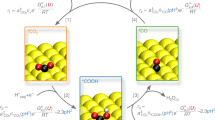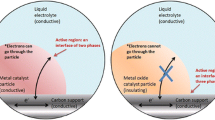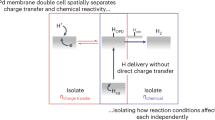Abstract
In the present work, an important point concerning the NEMCA effect is addressed. We analyse the reasons why the changes in the work function Φ of the gas exposed catalyst-electrode surface are one to one related to the changes in the catalyst working electrode potential E with respect to a reference electrode. It is concluded that this is due to the unique properties of the catalyst/solid electrolyte interface: the structure of the double layer in this region is very different from that in liquid electrolytes, being the potential difference at this interface mainly determined by the specific adsorption of the mobile species in the solid electrolyte.


Similar content being viewed by others
Notes
This assumption on the composition of this solid electrolyte is made for concrete discussion purposes. A similar analysis could be made for example with Y203-stabilized ZrO2, replacing Na + by O2– as conducting ion.
References
Vayenas CG, Neophytides SG (1996) In: Catalysis, vol 12. Royal Society of Chemistry, London, pp 199–253
Vayenas CG, Jaksik MM, Bebelis S, Neophytides SG (1996) In: Bockris JGM, Conway BE, White RE (eds), Modern aspects of electrochemistry, vol 29. Plenum, New York, pp 57–202
Vayenas CG, Yentekakis LV (1997) In: Ertl G, Knotzinger H, Weitcamp J (eds), Handbook of catalysis. VCH, Weinheim, pp 1310–1338
Williams FJ, Aldao CM (1999) Surface Sci 425:L387
Vayenas CG, Tsiplakides D (2000) Surface Sci 467:23
Vayenas CG (2000) J Electroanal Chem 486:85
Parsons R (2000) J Electroanal Chem 486:91
Trasatti S (1982) J Electroanal Chem 139:1
Trasatti S (1990) Electrochim Acta 35:269
West AR (1992) Solid state chemistry and its applications. Wiley, East Kilbride, Scotland
Vayenas CG, Bebelis S, Yentekakis V, Lintz H-G (1992) Catal Today 11:303
Lang ND (1971) Phys Rev B 4:4234
Hansen WN, Kolb DM (1979) J Electroanal Chem 100:493
Hansen WN (1983) J Electroanal Chem 150:133
Katz ER, Neff H, Miller K (1986) J Electroanal Chem 215:331
Same Z, Johnson BW, Doblhofer K (1992) Surface Sci 264:440
Tsiplakides D, Vayenas CG (2001) J Electrochem Soc 148:E189
Tsiplakides D, Vayenas CG (2002) Solid State lonics 152/153:625
Riess I, Vayenas CG (2003) Solid State lonics 159:313
Vayenas CG, Brosda S, Pliangos C (2003) J Catal (in press)
Acknowledgements
We thank CONICET, Agencia Cordoba Ciencia, Secyt UNC and Program BID 1201/OC-AR PICT No 06-04505 for financial support. Language assistance by Karina Plasencia is gratefully acknowledged.
Author information
Authors and Affiliations
Corresponding author
Additional information
Dedicated to Prof. Wolf Vielstich on the occasion of his 80th birthday in recognition of his numerous contributions to interfacial electrochemistry
Rights and permissions
About this article
Cite this article
Leiva, E.P.M., Sánchez, C.G. NEMCA effect: why are the work function changes of the gas exposed catalyst-electrode surface one-to-one related to the changes in the catalyst working electrode potential?. J Solid State Electrochem 7, 588–592 (2003). https://doi.org/10.1007/s10008-003-0417-5
Received:
Accepted:
Published:
Issue Date:
DOI: https://doi.org/10.1007/s10008-003-0417-5




